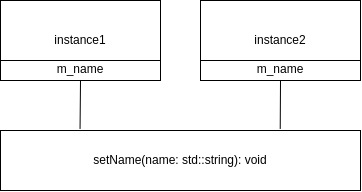We all know that there is only one copy of function exist’s for N number of objects or instance of a given class.
If you don’t understand the above sentence let me first explain with some example
1
2
3
4
5
6
7
8
9
10
class Laptop
{
public:
auto setName(const std::string& name) -> void
{
m_name = name;
}
private:
std::string m_name = "Dell";
};
Here we have a class called Laptop, and we can create ‘N’ number of instances from this class. Then we have ‘N’ number of std::string variable get’s created with name m_name (Technically name mangled m_name). That means if we create two instances, then these two instance has a two std::string variable (Technically object) gets created one for each instance. But tricky part or the fact is, This two instances hash only one copy of the function and it is shared between two instances.
Let me give some more clarification with example.
1
2
3
4
5
6
7
8
int main()
{
Laptop instance1;
Laptop instance2;
instance1.setName("Lenovo");
instance2.setName("Asus");
return 0;
}
In the above example we have created two instances instance1 and instance2. These two instances has its own copy of std::string object with name m_name. But these two instances shares the same function.

Now the question is how function know’s which instance’s m_name to use?
In order to know this we need to understand what compiler does internally during compilation.
What compiler does?
- Changes the function protoype and body like this
1 2 3 4
auto setName(Laptop* const this, const std::string& name) -> void { this->m_name = name; }
- Changed the caller of function like this
1 2
Laptop instance1; setName(instance1, "Lenovo");
Now it’s easy isn’t it? because function knows which object’s m_name to use. because its been passed as a first argument to all the member function of the class.
This is the beauty of this pointer. That’s why you could able to use this-> in all your member function of class which out being aware from where this magical this comes from.
Hey that fine, what about static function?
Yes, static function doesn’t have a this pointer because static function doesn’t belongs to instance of the class, rather it belongs to class.
What does it mean?
Let me show you an example by making setName as static function
1
2
3
4
static auto setName(const std::string& name) -> void
{
m_name = name;
}
As soon as you do this, you’r IDE will prompt with error pointing at m_name as
a nonstatic member reference must be relative to a specific objectC/C++(245)
Even then if you go ahead and try to compile you get this error
1
2
3
4
5
6
7
8
bhavith@bhavith:~$ g++ main.cpp
main.cpp: In static member function ‘static void Laptop::setName(const string&)’:
main.cpp:10:9: error: invalid use of member ‘Laptop::m_name’ in static member function
10 | m_name = name;
| ^~~~~~
main.cpp:13:17: note: declared here
13 | std::string m_name = "Dell";
| ^~~~~~
From this we know that static function cannot have a this pointer as a first argument to its function and it does not belongs to any of the instances rather its an independent function exist in class and can access only static member variables.